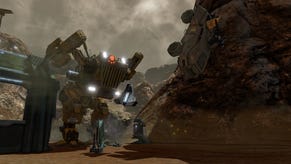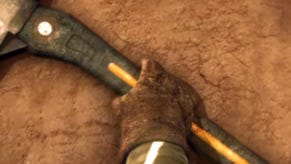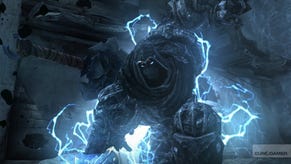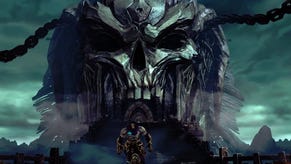Red Faction Guerrilla
War on Terra.
To begin with you're armed with a serviceable assault rifle, a small supply of remote charges and your trusty sledgehammer, which carves through solid walls with unlikely - but enjoyable - ease. The latter two are your initial tools for demolition, and even with this basic equipment it's easy to see how the robust damage model influences gameplay. Identifying load-bearing walls and crucial supporting structures makes demolition a much faster process than simply peppering the place with bombs, although the latter is fun enough that you'll still keep doing it even when a more scientifically sound solution is available. Weaken a building enough - which means not only doing enough damage, but doing it in the right spots - and the joypad will rumble ominously, giving you a few seconds warning before the whole lot comes down on your head.
It's instantly gratifying, and chances are you'll spend a decent chunk of your first hour on the game just smashing and exploding stuff to see what happens. As fun as it is, though, it's just a mechanism - and one that requires a compelling gameplay framework to endure.
It's here that Guerrilla struggles, at least to begin with, and following those first giddy destructive sprees, the game settles into something of a rut as you battle through the first two sectors. Like most openworld games, too much time is spent navigating from A to B, and the Martian scenery doesn't have the sort of life or vibrancy that allows GTA to make the journey something that can entertain in its own right.
The difficulty can also be frustrating in the early stages, as EDF troops easily gun you down, their numbers bolstered by an apparently limitless supply of reinforcements that can flank you in an instant. It's especially problematic if you're tackling those key EDF targets, essentially making any attempt at tactical play redundant since you can never clear the area long enough to plant your bombs in peace. Instead you end up dashing into the thick of things, doing as much damage as possible, then trying to leg it out again before you get killed.

You have recharging health, and any damage done to key structures remains even if you have to respawn back at the nearest Red Faction base, but these repeated suicide runs are wearying rather than exhilarating. Given the focus on demolition, it almost seems as if the game is crying out for more stealth-based options. Sneaking into fortified positions, setting charges and then detonating from a safe distance would be much more rewarding, but the crude run-and-gun combat system, augmented with only rudimentary crouch and cover abilities, combine with aggressively efficient enemies to steamroller any attempts to bring nuance to your play.
Many players may even lose interest completely during this first third or so of the game. After three or four hours of play, Guerrilla seems to be falling into the trap of so many other free-roaming games, with too much trekking, too many restarts and too little to keep things focused. The lynchpin thrill of destruction dims as the grind takes over.
Thankfully, it's a temporary dip and by the time you move into the Badlands, the pace has picked up again and you start to unlock interesting features and weapons that diminish some of the grumbles. This shift starts when you acquire the nano-rifle, which dismantles both walls and enemies at a molecular level, and precise demolition from afar suddenly becomes a much more feasible option. The map opens out at the same time, offering missions into more new areas - such as the posh, gated Oasis district where moneyed settlers drive groovy sci-fi sports cars - and it no longer feels like you're being funnelled into discreetly restricted playgrounds, recognisable only by their slightly different shade of dusty red.








